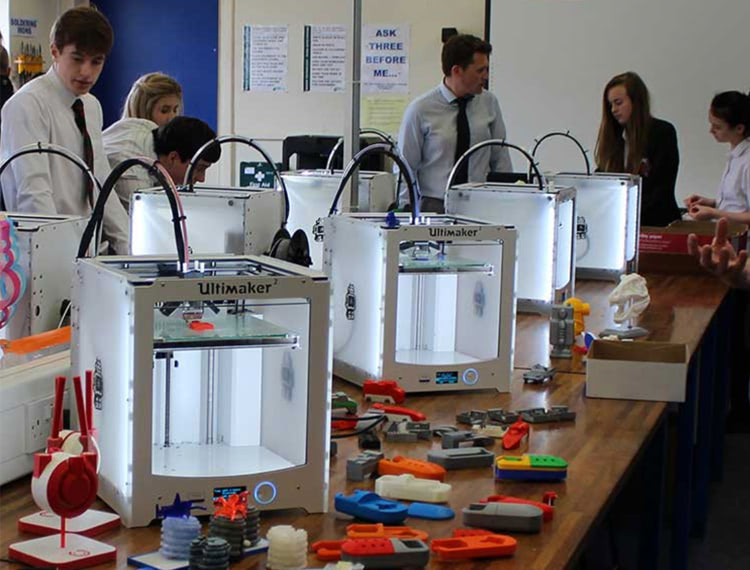Transforming Learning with 3D printing

3D printing can completely change the way students learn. It’s a technology that has the ability to transform industries such as manufacturing, engineering, architecture, art, aerospace, science and of course, education. By building up an object through tiny layers of material, a 3D printer can transform a digital design file into tangible reality.
Siert Wijnia, CTO and co-founder of Ultimaker, explores how putting 3D printing into the hands of today’s youth can transform innovation in tomorrow’s business.
Embracing Technology
Luke Johnson, Chairman of Risk Capital Partners, wrote in a letter to the Financial Times back in 2014:
“Invention is the talent of youth, as judgment is of age”. But even if I can’t be an inventor, I can perhaps encourage others to start inventing early. And a device that is built for such activity is the 3D printer.
With students even more familiar today than they were in 2014 with visualisation technology through innovations in video games, Virtual Reality and Augmented Reality, 3D printing comes naturally as they can turn an idea into something tangible.
Applications of 3D printing in education and learning are only limited by our own imagination as we can see from the applications through such initiatives as the Create Education Project. It requires creative thinking which makes it a great art form, as well as innovative thinking, helping foster problem-solving skills and invention.
Schools and education bodies have used 3D printing for:
- History projects – helping students understand complex structures like the colosseum in Rome
- Science – where secondary school girls in Lancaster considering careers in medicine and engineering were challenged to design and make a 3D-printed model of an animal cell for use in teaching
- Geography – by printing maps in 3D format showing landscapes that you can normally only see in an aerial view.
3D printing gives a whole new dimension to learning and applies technology to all subjects.
Mastering the Skill of 3D Printing
Mastering the skill of 3D printing can have a tremendous impact on the formation of the future workforce. Students that have used 3D printing to learn, will look to apply knowledge differently, interacting with their ideas and evolving their thinking faster. Due to the fact that 3D printing has become very hands-on with the introduction of desktop 3D printing, learners are more engaged than they are with passive learning, such as reading textbooks. The technology gives students the option to apply their knowledge and then modify and tweak 3D printed creations until satisfied with the result.
Many organisations seek this entrepreneurial spirit in their workforce as it encourages innovation and collaboration. Cultural change can be difficult – especially in organisations that have certain ways of working deeply embedded in them. And, whilst many are undergoing digital transformation and implementing new processes to support new business strategies, 3D printing should be considered a vital tool to encourage innovation and critical thinking.
Working together
If the benefits of 3D printing are so obvious, the question becomes “rather than waiting for this generation to hit the workforce, how can businesses and educational bodies work better together?”
The most commonly cited barriers are having the tools to implement 3D printing – i.e. the printers and software – as well as the understanding of how these tools can be used to teach certain subjects. Some businesses are already linking with local schools for other reasons, but organisations who see a future in 3D printing would be wise to consider investing in their up and coming local workforce by providing students with tools and education around the opportunities that the technology brings.
Pioneers in 3D printing are also investing in the education sector. For example, the European Schoolnet’s Future Classroom Lab has been working with education and ICT providers since 2012 to rethink the role of pedagogy, technology and design in the classroom.
The initiative encourages technology leaders such as Ultimaker and Create Education to collaborate with policy makers, industry leaders, teachers and other education stakeholders to explore new ways of teaching and learning through 3D printing.
Whilst this is one way to invest for the long-term, companies can also invest in educating their current workforce who may not be aware of the multiple applications of 3D printing. By planting these seeds of thought, a better educated workforce can use their collective creativity to come up with new applications for 3D printing relevant to their job.
3D printing is beginning to make its mark in education but there is huge potential for more educational bodies to get involved. Just as business is undergoing digital transformation, so must the way in which we encourage learning.
Having 3D printing embedded as a learning method at an early age brings a host of benefits relevant to business as these young minds enter the workforce – they will be far more empowered to be the harbinger of innovation, creativity and collaboration for which business is calling.
Siert Wijnia, CTO and co-founder of Ultimaker











Responses